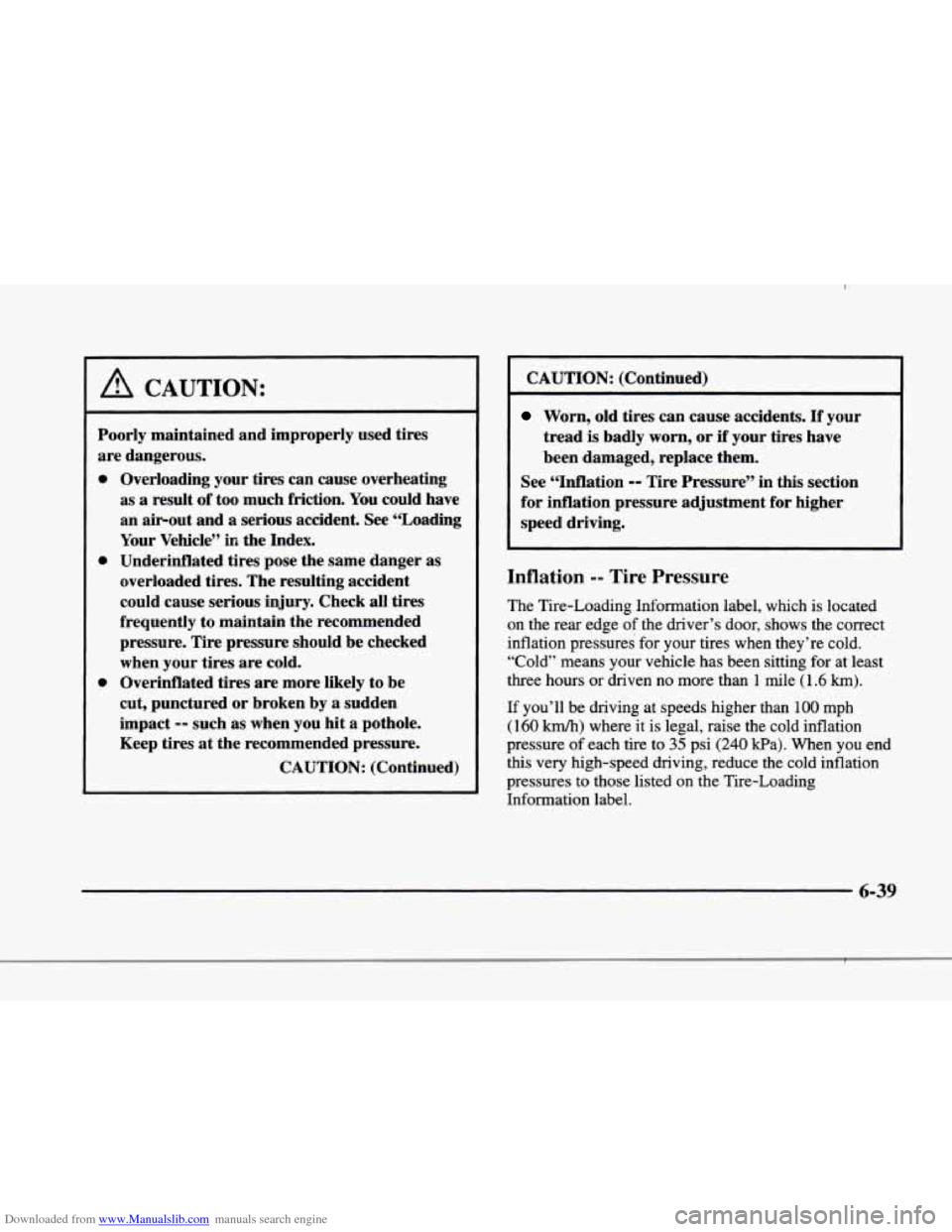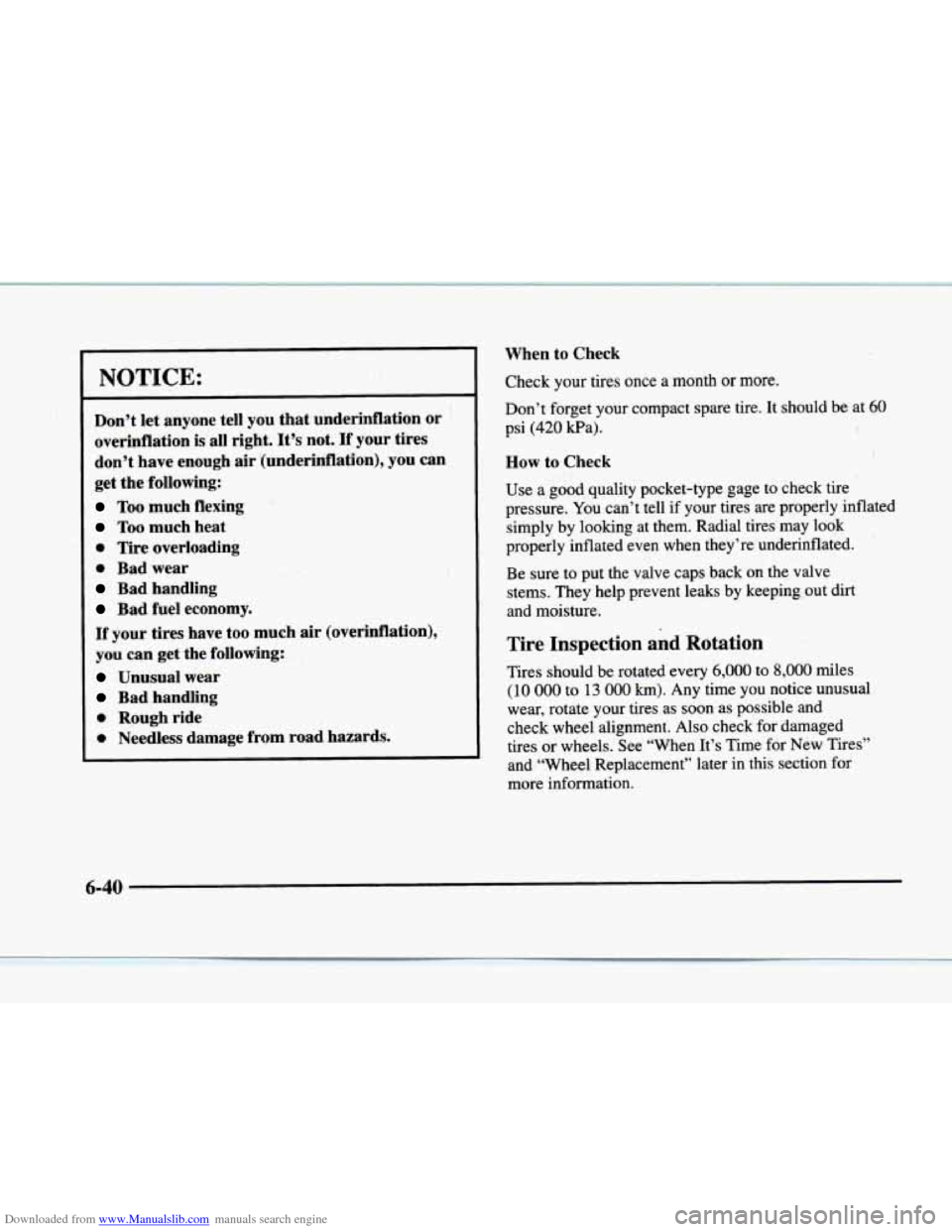Page 313 of 380
Downloaded from www.Manualslib.com manuals search engine I
rl
..
'I.
2. Lift off the cover as shown. 3. Turn the headlamp housing socket to the left to
unlock the socket from the lamp housing.
6-33
Page 314 of 380
Downloaded from www.Manualslib.com manuals search engine 4. Remove the headlamp housing socket. 5. After removing th'e wiring harness from the
headlamp housing socket. replace the
bulb and
socket. Reconnect it to the wiring harness and
reinstall
the headlamp housing socket back into the
headlamp assembly.
6-34
Page 315 of 380
Downloaded from www.Manualslib.com manuals search engine Front Turn Signal Lamps
1. The turn signal lamps are located on the outboard
side
of the headlamps. To access, turn the lock tabs
on the headlamp cover in the direction
of the arrows
and then lift off the cover (see Steps 1 and 2 under
"Headlamps").
r
h
2. Turn the housing socket to the right to unlock the
socket
from the lamp housing.
..
.C -
.
3. Remove the tuin signal lamp housing socket and
replace
the bulb.
6-35
Page 316 of 380
Downloaded from www.Manualslib.com manuals search engine Center High-Mounted Stoplamp (CHMSL)
1. Lift the trim cover to remove.
2. Twist the socket to the left and remove the socket
and bulb from the housing.
Reverse the steps to reassemble the stoplamp assembly.
6-36
Page 317 of 380
Downloaded from www.Manualslib.com manuals search engine P
!-
P
Rear Turn Signal Lamps and Taillamps
1. Open the trunk to gain access to the lamp housing.
2. Remove the convenience net and pull the trim away
to access the wing
nuts.
3. Remove the two wing nuts.
4. Gently remove the lamp housing.
A
5. Press the bulb housing lever and rotate the housing
to the left to remove
it. To remove the bulb, push and
rotate
it to the left.
Once you have replaced the burned-out bulb, reverse the
steps to reassemble the lamp assembly.
6-37
Page 318 of 380
Downloaded from www.Manualslib.com manuals search engine Windshield Wiper
Blade Replacement
It’s a good idea to clean or replace the wiper blade
assembly
on a regular basis or when worn. For proper
windshield wiper blade length and type, see “Normal
Maintenance Replacement
Parts” later in this section.
To replace the wiper blade assembly:
1. Turn the ignition key to ACCESSORY and turn the
wipers on. Position the wipers on the windshield
in
the “mid” wipe position. Then with the door open,
turn the key to
OFF.
2. Insert a screwdriver into the slot as shown and press
down to release the wiper blade assembly.
3. Align the wiper arm pin with the hole on the wiper
blade assembly and snap
it into place to install.
Tires
Your new vehicle comes with high-quality tires made by
a leading tire manufacturer. If you ever have questions
about your tire warranty and where
to obtain service, see
your Cadillac Warranty booklet for details.
6-38
Page 319 of 380

Downloaded from www.Manualslib.com manuals search engine r
r
!
r
I
r
r
I
r
I- t
A CAUTION:
~~ ~~
Poorly maintained and improperly used tires
are dangerous.
0
0
0
Overloading your tires can cause overheating
as a result of too much friction. You could have
an air-out and a serious accident. See “Loading
Your Vehicle”
h the Index.
UnderinfJated tires pose the same danger as
overloaded tires. The resulting accident
could cause serious injury. Check all tires
frequently to maintain the recommended
pressure. Tire pressure should be checked
when your tires are cold.
Overinflated tires are more likely to be
cut, punctured or broken by a sudden
impact
-- such as when you hit a pothole.
Keep tires at the recommended pressure.
CAUTION: (Continued) CAUTION: (Continued)
Worn, old
tires can cause accidents. If your
tread
is badly worn, or if your tires have
been damaged, replace them.
See “Inflation
-- Tire Pressure” in this section
for inflation pressure adjustment for higher
speed driving.
Inflation -- Tire Pressure
The Tire-Loading Information label, which is located
on the rear edge of the driver’s door, shows the correct
inflation pressures for your tires when they’re cold.
“Cold” means your vehicle has been sitting for at least
three hours or driven
no more than 1 mile (1.6 km).
If you’ll be driving at speeds higher than 100 mph
(160 km/h) where it is legal, raise the cold inflation
pressure of each tire to
35 psi (240 kPa). When you end
this very high-speed driving, reduce the cold inflation
pressures
to those listed on the Tire-Loading
Information label.
6-39
Page 320 of 380

Downloaded from www.Manualslib.com manuals search engine NOTICE:
Don’t let anyone tell you that underinflation or
overinflation
is all right. It’s not. If your tires
don’t have enough air (underinflation), you can
get
the following:
Too much flexing
Too much heat
0 Tire overloading
0 Bad wear
Bad handling
Bad fuel economy.
If your tires have too much air (overinflation),
you can get the following:
Unusual wear
Bad handling
0 Rough ride
0 Needless damage from road hazards. When
to Check
Check your tires once a month or more.
Don’t forget your compact spare tire. It should be at
60
psi (420 Wa).
How to Check
Use a good quality pocket-type gage to check tire
pressure.
You can’t tell if your tires are properly inflated
simply by looking
at them. Radial tires may look
properly inflated even when they’re underinflated.
Be sure to put the valve caps back on the valve
stems. They help prevent leaks by keeping out dirt
and moisture.
Tire Inspection and Rotation
Tires should be rotated every 6,000 to 8,000 miles
( 10 000 to 13 000 km). Any time you notice unusual
wear, rotate your tires as soon as possible and
check wheel alignment. Also check for damaged
tires or wheels. See “When It’s Time for New Tires”
and “Wheel Replacement” later in this section for
more information.
a